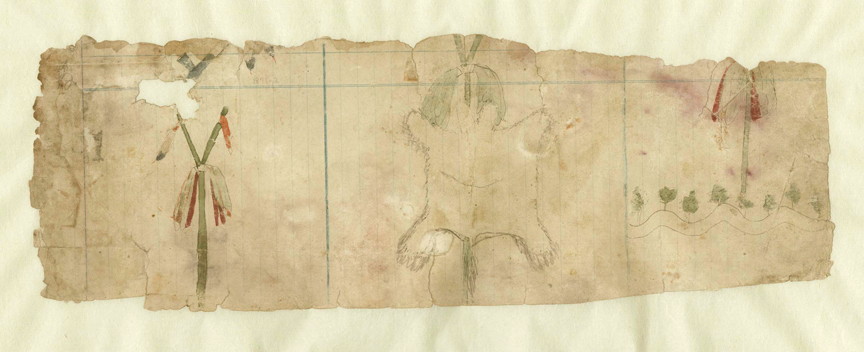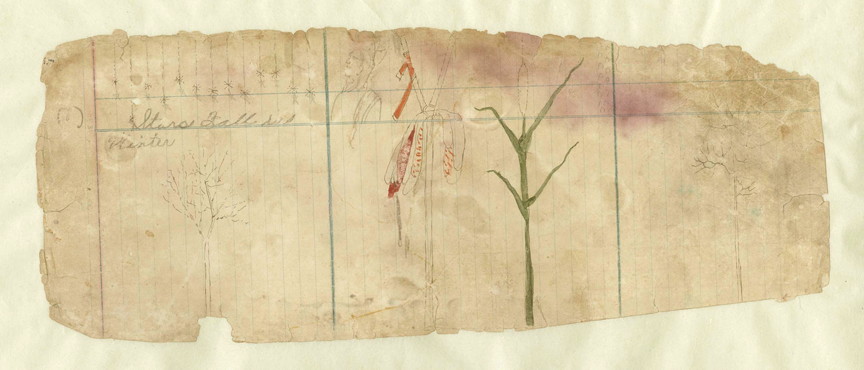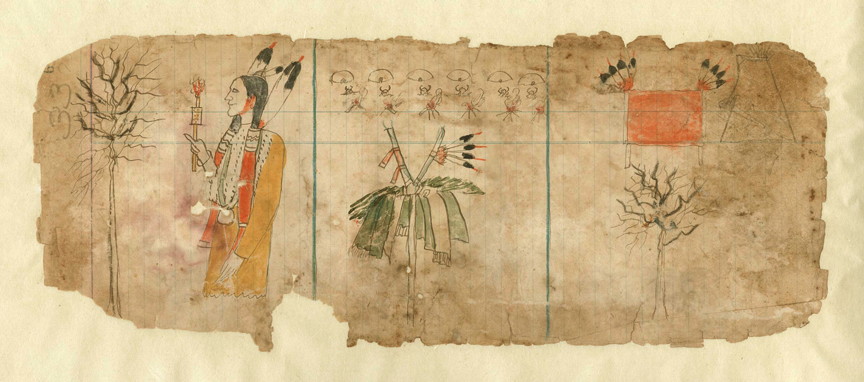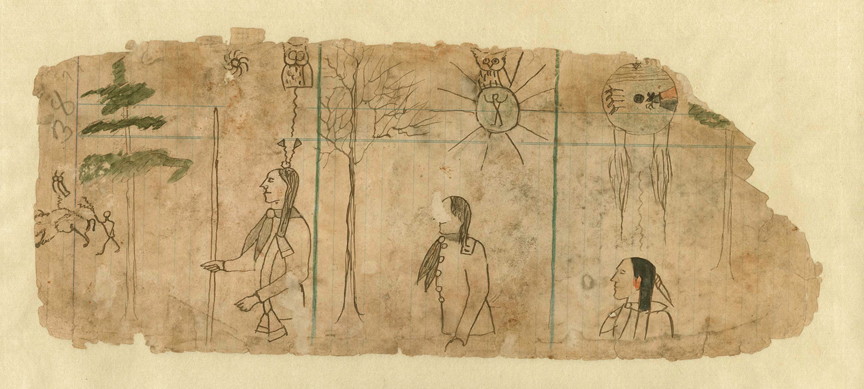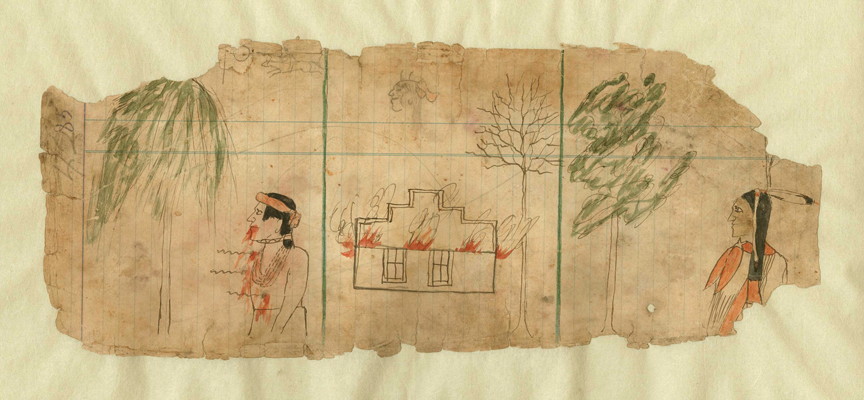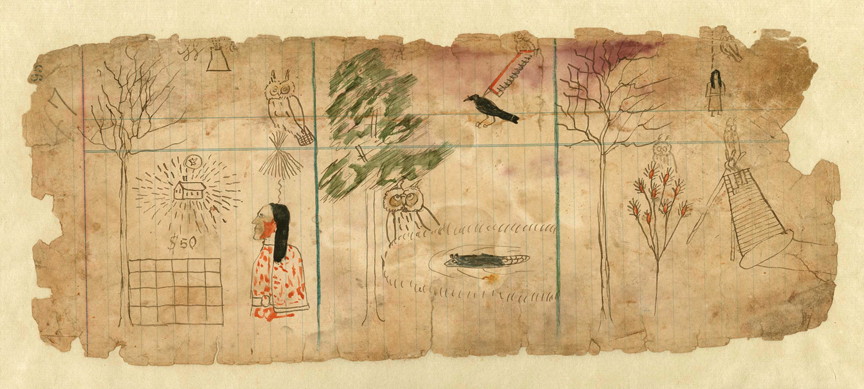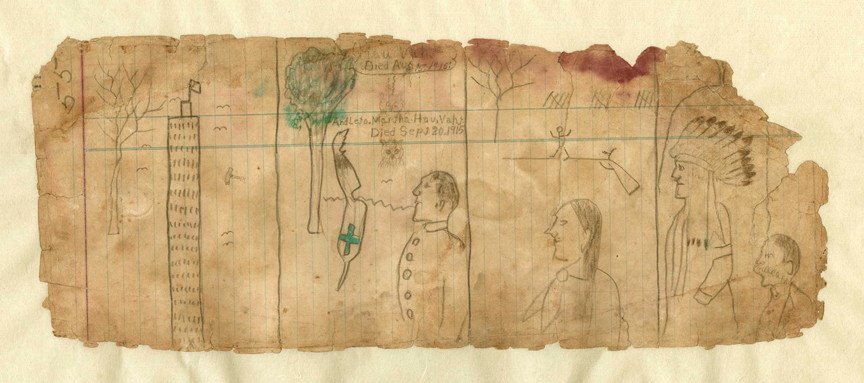Teachers Resource Site
This online exhibition and teacher resource features the calendar drawings of Kiowa artist and calendar-keeper Silver Horn. The images depict key events in the history of the Kiowa people between 1828 and the winter of 1928-29. The descriptions were prepared by Candace Greene, ethnologist at the Smithsonian Institution in Washington D.C.
In the traditional Kiowa calendar, each year is represented by two images – one for the summer and one for the winter. The events depicted are agreed upon by tribal elders and drawn and maintained by designated tribal calendar-keepers, like Silver Horn. The calendar records were originally kept on hides or cloth, but eventually were copied into ledgers.
Silver Horn was born in 1860 (“The Summer That Bird Appearing was Killed,” according to his calendar). Both his father and older brother also were calendar-keepers for the tribe. He was a prolific artist, and created hundreds of drawings representing Kiowa history and tradition before his death in 1940.
This calendar was donated to the Sam Noble Oklahoma Museum of Natural History in 2001 from the estate of Nelia Mae Roberts, who ran an Indian trading post in Anadarko. The museum subsequently received a Save America’s Treasures Grant that provided for the conservation and restoration of the calendar’s fragile pages by a professional paper conservator. The process took over a year, and the restored pages went on display for the first time in the museum from May 1 through Aug. 23, 2009. For conservation reasons, the calendar has now been returned to the safety of the museum’s ethnology collections, but the images can still be viewed and studied through this online exhibition.
Only one other full Silver Horn calendar is known to exist today. It was created by Silver Horn in 1904 specifically for the archives of the Smithsonian Institution and covers the period from 1828 through 1904.
1828-1829-1830
1828 Pipe Dance Summer1829 Buffalo Hide Summer1830 Dry Creek Summer Read More
1831-1832-1833
1831 Woman Hanged Summer 1832 Wolf Creek Summer 1832-33 Unnamed winter 1833 Cut Off Their Heads Summer Read More
1833-1834-1835-1836
1833-34 Stars Fall Winter 1834 1834-35 1835 Water Plant Summer 1835-36 Unnamed winter Read More
1836-1837-1838
1836 1836-37 1837 Wailing Summer 1837-38 Buffalo's Son died winter 1838 Read More
1838-1839-1840
1838-39 Taimpego organized winter 1839 Peninsula Summer 1839-40 Smallpox winter Read More
1840-1841
1840 Smallpox Summer 1840-41 Hide quiver winter 1841 Unnamed summer Read More
1841-1842-1843
1841-42 Sloping Hair killed winter 1842 Repeated Summer 1842-43 Heap of Bears killed winter Read More
1843-1844
1843 Nest Building Summer 1843-44 Unnamed winter 1844 Sioux Summer Read More
1844-1845-1846
1844-45 Horse Corral winter 1845 Stone Necklace died Summer 1845-46 Thunder Boy killed winter Read More
1846-1847
1846 Measles Summer 1846-47 Shot mustache winter 1847 Red Sleeve killed summer Read More
1847-1848-1849
1847-48 Windbreak winter 1848 Koitsenko initiated Summer 1848-49 Ice rising winter Read More
1849-1850
1849 Cramp Summer 1849-50 Pawnee killed winter 1850 Chinaberry Summer Read More
1850-1851-1852
1850-51 Deer killed winter 1851 Dusty Summer 1851-52 Woman frozen winter Read More
1852-1853
1852 Surround fight summer 1852-53 Pawnee boy ran away winter 1853 Showery Summer Read More
1853-1854-1855
1853-54 Black Bear died winter 1854 Timber Mountain Summer 1854-55 Likes Enemies killed winter Read More
1855-1856
1855 Long haired Pawnee killed summer 1855-56 Going on the Road killed winter 1856 Prickly Pear Summer Read More
1856-1857-1858
1856-57 Loud Talker shot winter 1857 Forked stick sprouted Summer 1857-58 Pawnees stole horses winter Read More
1858-1859
1858 Timber Circle Summer 1858-59 Wolf Lying Down killed winter 1859 Timber Clearing Summer Read More
1859-1860-1861
1859-60 On the Gun killed winter 1860 Bird Appearing killed summer 1860-61 Crazy Bluff winter Read More
1861-1862
1861 Spotted horse tied Summer 1861-62 Smallpox winter 1862 Smallpox Summer Read More
1862-1863-1864
1862-63 Horses ate ashes winter 1863 No Arm's Summer 1863-64 Big Head died winter Read More
1864-1865
1864 Ragweed Summer 1864-65 Fight with Ute at Red Bluff winter 1865 Peninsula Summer Read More
1865-1866-1867
1865-66 Old Man Wagon died winter 1866 Flat Metal Summer 1866-67 Struck His Head Against a Tree killed winter Read More
1867-1868
1867 Koitsenko initiated Summer 1867-68 Treaty winter 1868 Without Horn killed Summer Read More
1868-1869-1870
1868-69 Black Kettle killed winter 1869 Warbonnet captured Summer 1869-70 Frightened by bugle winter Read More
1870-1871
1870 Plant growing Summer 1870-71 Kill on the Mountain killed winter 1871 White Buffalo given a pipe summer Read More
1871-1872-1873
1871-72 Pawnee visit winter 1872 Bird Bow killed summer 1872-73 Battle tipi burned winter Read More
1873-1874
1873 Black Buffalo's horses killed Summer 1873-74 Lone Wolf's son killed winter 1874 End of Mountains Summer Read More
1874-1875-1876
1874-75 Kiowa prisoners to jail 1875 Love Making Spring Summer 1875-76 Given sheep winter Read More
1876-1877
1876 Sun Boy's horses stolen Summer 1876-77 Rode a buffalo winter 1877 Measles Summer Read More
1877-1878-1879
1877-78 Arrow woman winter 1878 Repeated Summer 1878-79 White Cowbird killed winter Read More
1879-1880
1879 Horse eating Summer 1879-80 Red Buffalo died winter 1880 Big Bow died Read More
1880-1881-1882
1880-81 Dance winter 1881 Sweat lodge Summer 1881-82 Red blanket winter Read More
1882-1883
1882 Nez Perces visited summer 1882-83 Bag shot himself winter 1883 Nez Perces came again Summer Read More
1883-1884-1885
1883-84 Grass money winter 1884 Woman killed by lightening summer 1884-85 Snapping Turtle stole a woman winter Read More
1885-1886
1885 Peninsula Summer 1885-86 Tipis burned winter 1886 Big Bow killed a horse thief summer Read More
1886-1887-1888
1886-87 Quiver's son killed himself winter 1887 Oak Creek Summer 1887-88 Cattle issued winter Read More
1888-1889
1888 Peyote Man died summer 1888-89 Sun Boy died winter 1889 Stumbling Bear's son died summer Read More
1889-1890-1891
1889-90 Pipe dance winter 1890 Unfinished Summer 1890-91 Boys frozen winter Read More
1891-1892
1891Snapping Turtle shot a man summer 1891-92 Scouts enlisted winter 1892 Measles summer Read More
1892-1893-1894
1892-93 White Horse died winter 1893 Big boy summer 1893-94 Little Bluff died winter Read More
1894-1895
1894 Caddo man killed 1894-95 Quinette's store burned winter 1895 White Bear's brother died summer Read More
1895-1896-1897
1895-96 Payment at Rainy Mountain 1896 Kiowa girls run away summer 1896-97 White Feather shot winter Read More
1897-1898
1897 Council at Mount Scott summer 1897-98 Leader died winter 1898 Poncas visit and dance summer Read More
1898-1899-1900
1898-99 First train winter 1899 Second Council at Mount Scott summer 1899-00 Woman burned winter Read More
1900-1901
1900 Prairie Chicken died summer 1900-01 Measles winter 1901 Check fraud summer Read More
1901-1902-1903
1901-02 Land allotted winter 1902 Crow Lance and Beaver died summer 1902-03 Bed died winter Read More
1903-1904
1903 Payment winter 1903-04 Eye sore winter 1904 Many died summer Read More
1904-1905-1906
1904-05 Red Stone church built winter 1905 Great cyclone summer 1905-06 Red Horse winter Read More
1906-1907
1906 Killed by train summer 1906-07 Frizzle Head died winter 1907 Rainy summer Read More
1907-1908-1909
1907-08 Two died winter 1908 $100 payment summer 1908-09 50 payment winter 1909 Visited Crow summer Read More
1909-1910-1911
1909-10 Woman shot winter 1910 Poor Bear died summer 1910-11 Quanah died winter 1911 Feather Dance Circle summer Read More
1911-1912-1913
1911-12 Overtaken by a storm winter 1912 Many storms summer 1912-13 Went to Washington winter Read More
1913-1914
1913 One Arm came summer 1913-14 Boy was shot winter 1914 Pipe Dance summer Read More
1914-1915-1916
1914-15 First flight winter 1915 Broke the Feather Dance summer 1915-16 On the Gun elected winter 1916 Dance summer Read More
1916-1917-1918
1916-17 Delegation to Washington winter 1917 Ohoma Dance summer 1917-18 Sun Boy winter 1918 Medicine Lodge summer Read More
1918-1919
1918-19 Veterans Honored winter 1919 Summer Read More
1919-1920-1921
1919-20 Delegation to Washington winter 1920 Medicine Lodge held again summer 1920-21 Ghost Dance leader died winter 1921 Ceremony in Washington summer Read More
1921-1922-1923
1921-22 Spotted Horse died winter 1922 Prayer meeting summer 1922-23 Hook died winter 1923 Lone Wolf summer Read More
1923-1924-1925-1926
1923-24 Big Nose died winter 1924 Many died summer 1924-25 Big fire winter 1925 Six Moons was shot summer 1925-26 Unmarked winter Read More
1926-1927-1928
1926 Unmarked summer 1926-27 Three died winter 1927 Medicine Lodge anniversary summer Read More




